A fascinating look at the cold and challenging job of photographing a walrus underwater by photographer Paul Nicklen.
As of Monday evening, local time, 478 passengers and crew have been rescued from the burning ro/ro ferry Norman Atlantic, which caught fire Sunday morning around 6 AM in the Adriatic Sea. At least 7 people have died. Many of the passengers and crew were evacuated by helicopter. The rescue was hampered by torrential rain and strong winds reaching 100 kilometers per hour. As reported by CNN: It’s not known how the fire started, but it’s believed to have originated in the parking bay. A truck driver told the Greek news media that trucks filled with oil were “packed like sardines,” their cargo scraping the ceiling, which could have set off sparks in rough seas to start a fire, he surmised. Greek authorities said the vessel’s fire doors appeared to have failed, which allowed the flames to spread quickly.
Huge plumes of black smoke billow from burning Norman Atlantic ferry
A fire broke out early Sunday on the Italian ro/ro ferry, Norman Atlantic, on route between the Greek port of Patras to Ancona, Italy with 478 passengers and crew aboard. The fire is believed to have broken out on the ro/ro deck. The ship is currently drifting west of the island of Corfu in the Adriatic Sea. Rescue efforts are underway but are being hampered by gale force winds, high seas and bitterly cold conditions. 150 people are reported to have escaped the burning ship. The rest of the passengers and crew have sought refuge on the vessel’s bridge deck. There are no reported casualties. Attempts to airlift passengers off the burning ferry have begun but are being made difficult by high winds. Salvage tugs have been dispatcher from both Italy and Greece.
The Norman Atlantic is a 2009 built, Italian registry, 26,900-tonne, roll-on roll-off ferry chartered by Greek ferry company ANEK. Shipping Minister Miltiadis Varvitsiotis is quoted as saying, “We are doing everything we can to save those on board and no one, no one will be left helpless in this tough situation. It is one of the most complicated rescue operations that we have ever done.”
ITALIAN FERRY BURNING in ADRIATIC (VIDEO) NORMAN ATLANTIC on FIRE
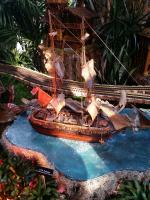
USS Porpoise made of bark, vines and twigs from the Botanic Garden
While visiting family in Washington DC, we visited the United States Botanic Garden. The Garden has a holiday exhibit that features model trains, specifically, Thomas the Tank Engine, which delighted my 2 year old grand nephew. In addition to the trains and numerous models of buildings built from twigs, bark, branches and other material collected from the gardens themselves, there were also two ships from the United States Exploring Expedition of 1838 to 1842, lead by Lieutenant Charles Wilkes. The sloop of war USS Vincennes and the the brig USS Porpoise are also fancifully constructed from branches, wood, bark and vines collected from the gardens. But what did Wilkes and his squadron have to do with the gardens? More than I realized before my visit.
The United States Botanic Garden was founded with plants brought back from the Wilkes Expedition. It is the oldest continually operating botanic garden in the nation. As noted on the Botanic garden website:
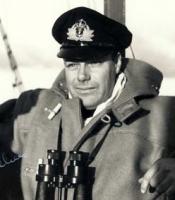
Alan Villiers
While not a particular believer in ghosts, if the ghost of Alan Villiers is about, I suspect that he must smiling. The arrival of the Mayflower II at Mystic Seaport Museum is the reunion, of sorts, of two ships long associated with the sailing ship captain and pioneer in sail training. In mid December, the Mayflower II was towed from Plymouth, MA to the Henry B. duPont Preservation Shipyard at Mystic Seaport in Connecticut where she will begin the first phase of a multi-year restoration.
The Mayflower II, a replica of the original ship which carried the Pilgrims across the Atlantic in 1620, has been the one of the key exhibits at the Plimoth Plantation at the State Pier on Plymouth’s waterfront. In 2013, the ship was found to be in need of a major refit. As noted on the Mystic Seaport website:
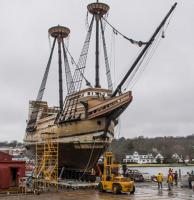
Mayflower II
“The restoration of the 57-year-old wooden ship will be carried out over several years with the ship spending winter and spring at Mystic Seaport and returning to Plymouth each summer and fall. The project is scheduled for completion prior to 2020–the 400th anniversary of the Pilgrims’ arrival.”
So what does this have to do with Alan Villiers? Continue reading
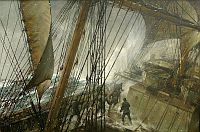 We hope that everyone is having a most merry Christmas. Here is a poem by C. Fox Smith adapted for song by Charlie Ipcar. As we posted last June, Cecily Fox Smith was a Victorian poet best remembered for her poems about ships and sailors in the last days of the age of sail. She wrote more than 600 poems which were published in more than two dozen volumes. In recent years, her work has seen a revival as her poems have inspired musicians to write music to her verses. Over 70 of her poems have been adapted as songs, including this one.
We hope that everyone is having a most merry Christmas. Here is a poem by C. Fox Smith adapted for song by Charlie Ipcar. As we posted last June, Cecily Fox Smith was a Victorian poet best remembered for her poems about ships and sailors in the last days of the age of sail. She wrote more than 600 poems which were published in more than two dozen volumes. In recent years, her work has seen a revival as her poems have inspired musicians to write music to her verses. Over 70 of her poems have been adapted as songs, including this one.
By Cicely Fox Smith from Rhymes of the Red Ensign, edited by Cicely Fox Smith, published by Hodder and Stoughton, London, © 1919, pp. 71-72. Adapted for singing by Charlie Ipcar, © 12/26/08 Tune inspired by Christmas Day in the Morning
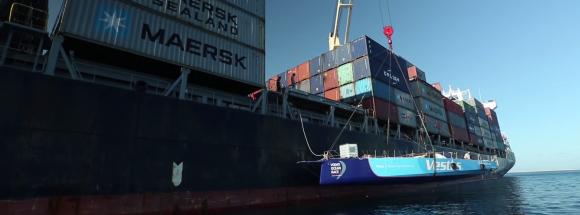 In the end of November, the Team Vestas Wind, racing in the Volvo Ocean Race, ran aground on a reef in the remote Cargados Carajos archipelago about 430 km to the northeast of Mauritius in the Indian Ocean. There were no injuries and the crew was rescued and taken to Mauritius. Before leaving, the crew and their support team promised to return to remove the Volvo 65 racing yacht from the reef. Given the remoteness of the archipepelago, no doubt many thought that this might be a promise unkept. Nevertheless, 24 days after the grounding, the Vestas Wind team successfully re-floated the yacht and arranged for a gear Maersk container ship to come hoist the wreck aboard. An impressive accomplishment to be sure. Click on the link below for a video of the salvage.
In the end of November, the Team Vestas Wind, racing in the Volvo Ocean Race, ran aground on a reef in the remote Cargados Carajos archipelago about 430 km to the northeast of Mauritius in the Indian Ocean. There were no injuries and the crew was rescued and taken to Mauritius. Before leaving, the crew and their support team promised to return to remove the Volvo 65 racing yacht from the reef. Given the remoteness of the archipepelago, no doubt many thought that this might be a promise unkept. Nevertheless, 24 days after the grounding, the Vestas Wind team successfully re-floated the yacht and arranged for a gear Maersk container ship to come hoist the wreck aboard. An impressive accomplishment to be sure. Click on the link below for a video of the salvage.
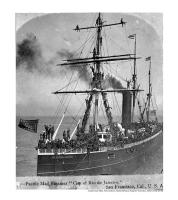
SS City of Rio de Janeiro
Recently, History.com featured an article titled “Found: San Francisco’s Deadliest Shipwreck.” They reported that the wreck of the 345-foot Pacific Mail Line passenger steamer SS City of Rio de Janeiro had been found by NOAA researchers using high-definition sonar in 287 feet of water just off the Golden Gate. When the ship ran aground in heavy fog in 1901 on a voyage from Hong Kong to San Francisco, 135 of the 220 passengers and crew aboard drowned, making it the most deadly shipwreck in San Francisco history. The ship reportedly sank in ten minutes after striking rocks on the the southern side of the Golden Gate near Fort Point. This is the first time that the shipwreck has been accurately mapped, although not necessarily the first time that it’s position has been identified.
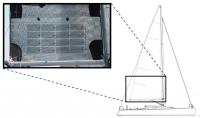 For roughly the last ten years, UK Sailmakers of Mandelieu, France has been developing Uni-Titanium sails, in which thin sheets of uni-directional carbon films are laminated into the sail. They are now partnering with the Solar Cloth Company of the UK to develop a main sail incorporating high efficiency flexible solar cells. The solar energy would be transported by an integrated flexible circuit through the sail’s luff and then to the foot of the mast . A small electronic controller would be installed inside the boat to control the battery charging. The boat’s dodger or a flexible boom tent could provide power while at anchor.
For roughly the last ten years, UK Sailmakers of Mandelieu, France has been developing Uni-Titanium sails, in which thin sheets of uni-directional carbon films are laminated into the sail. They are now partnering with the Solar Cloth Company of the UK to develop a main sail incorporating high efficiency flexible solar cells. The solar energy would be transported by an integrated flexible circuit through the sail’s luff and then to the foot of the mast . A small electronic controller would be installed inside the boat to control the battery charging. The boat’s dodger or a flexible boom tent could provide power while at anchor.
The Solar Cloth Company is a UK venture which is developing thin, lightweight and flexible solar panels that can be deployed like cloth on non-load bearing roofs. The firm is focusing on installing their “solar cloth” on the roofs of car parks, supermarkets and warehouses and has raised more than £771,850 in crowd-sourced funding to expand their operations.
At this point, carbon fiber photovoltaic sails are probably beyond the budget of most sailors. Nevertheless, at the rate at which solar cells have been falling in price, they may be in our future.

NASA’s Astronomy Picture of the Day: Today the solstice occurs at 23:03 Universal Time, the Sun reaching its southernmost declination in planet Earth’s sky. Of course, the December solstice marks the beginning of winter in the northern hemisphere and summer in the south. When viewed from northern latitudes, and as shown in the above horizontally compressed image, the Sun will make its lowest arc through the sky along the southern horizon. So in the north, the solstice day has the shortest length of time between sunrise and sunset and fewest hours of daylight. This striking composite image follows the Sun’s path through the December solstice day of 2005 in a beautiful blue sky, looking down the Tyrrhenian Sea coast from Santa Severa toward Fiumicino, Italy. The view covers about 115 degrees in 43 separate, well-planned exposures from sunrise to sunset.
On this the first day of Winter, as the darkness closes in around us, it seems appropriate to take a few minutes to escape, virtually at least, to shores where it is the first day of Summer. Here is a short video of Paula Novotná kite surfing the Brazilian lagoons Barra Nova and Cauipe. Shot and edited by Andre Magarao.
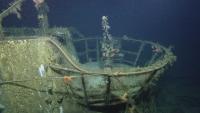
Photo: Ocean Exploration Trust
On July 30, 1942, Herbert Claudius in command of the patrol boat PC 566 was escorting passenger ship passenger ship Robert E. Lee in the Gulf of Mexico, southeast of the mouth of the Mississippi River. The German U-boat U-166 attacked and sank the passenger ship. Claudius and PC 566 fought back with gun fire and depth charges. They saw oil and debris and thought that they had sunk the German submarine, but they Navy did not believe their report.
Now 72 years later, a National Geographic/NOVA expedition located the wreck of U-166 which indeed had been sunk by Captain Claudius and the PC 566. The Navy has admitted its error. As reported by National Geographic: “Seventy years later, we now know that [Claudius’s] report after the action was absolutely correct,” Navy Secretary Ray Mabus said in a small ceremony attended by members of Claudius’s family.
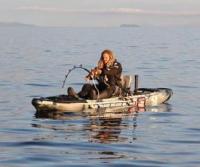
Photo: Joel Kayakangler Facebook page
Joel Abrahamsson, from Gothenburg, Sweden, recently caught a 15′ long 1,247 pound Greenland shark while fishing from a kayak near the island of Andoria, in Norway. The catch sets a new world record for a fish caught with a rod and reel from a kayak.
The Greenland shark is very rare, living in the deep and cold waters of the Arctic. To catch the shark, Abrahamsson lowered 1,600 of line, baited with eight pounds of coalfish as bait, from his kayak. When the shark bit, it took Abrahamsson an hour and a half to reel in the huge fish, which weighed as much as an adult polar bear and is believed to be up to 200 years old.
 Last May, we posted about concerns over high concentrations of sewage and garbage in Rio de Janeiro’s Guanabara Bay, where 2016 Olympic sailing competitions are slated to be held. Now scientists at a Rio de Janeiro research institute have found what they call a new antibiotic resistant “super-bacteria” in the same waters. As reported by The Telegraph:
Last May, we posted about concerns over high concentrations of sewage and garbage in Rio de Janeiro’s Guanabara Bay, where 2016 Olympic sailing competitions are slated to be held. Now scientists at a Rio de Janeiro research institute have found what they call a new antibiotic resistant “super-bacteria” in the same waters. As reported by The Telegraph:
The bacteria is similar to other known strains but is resistant to the usual drugs, said Ana Paula D’Alincourt Carvalho Assef, the coordinator of the study that was published on the Oswaldo Cruz’s website. Continue reading
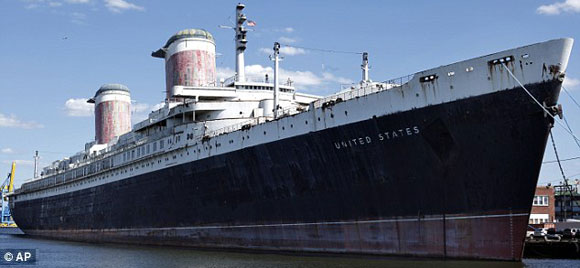 The SS United States Conservancy issued a press release signed by Susan Gibbs on Monday announcing:
The SS United States Conservancy issued a press release signed by Susan Gibbs on Monday announcing:
Exciting Redevelopment Milestone Achieved
We are very pleased to confirm that we have now entered into a preliminary agreement in support of the redevelopment of the SS United States. Negotiations have been underway for some time, and planning will continue with a variety of stakeholders. While further due diligence is conducted, the Conservancy will receive financial support to cover the vessel’s core carrying costs for at least an additional three months.
It is however not yet a done deal.
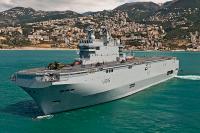 Back in 2010, we posted that some members of NATO were uncomfortable with a French contract to build two, with an option for two more, Mistral-class amphibious assault ships for Russia. The first ship, the Vladivostok, was supposed to be delivered to Russia in October but following Russian actions in the Ukraine, President François Hollande said France would postpone the delivery “until further notice.” The Russians are demanding that the French live up to the shipbuilding contract. Russian Deputy Defense Minister Yuri Borisov said, “Everything is specified in the contract, and we will act under that contract, just like all civilized people do.”
Back in 2010, we posted that some members of NATO were uncomfortable with a French contract to build two, with an option for two more, Mistral-class amphibious assault ships for Russia. The first ship, the Vladivostok, was supposed to be delivered to Russia in October but following Russian actions in the Ukraine, President François Hollande said France would postpone the delivery “until further notice.” The Russians are demanding that the French live up to the shipbuilding contract. Russian Deputy Defense Minister Yuri Borisov said, “Everything is specified in the contract, and we will act under that contract, just like all civilized people do.”
Joan Druett has a wonderful new book out — Eleanor’s Odyssey. Now available in paperback and soon as an ebook.
Eleanor’s Odyssey: Journal of the Captain’s Wife on the East Indiaman Friendship, 1799-1801 by Joan Druett
It was 1799, and French privateers lurked in the Atlantic and the Bay of Bengal. Yet Eleanor Reid, newly married and just twenty one years old, made up her mind to sail with her husband, Captain Hugh Reid, to the penal colony of New South Wales, the Spice Islands and India. Danger threatened, not just from the barely charted seas they would be sailing, yet, confident in her love and her husband’s seamanship, Eleanor insisted on going along. Joan Druett, writer of many books about the sea, including the bestseller Island of the Lost and the groundbreaking story of women under sail, Hen Frigates, embellishes Eleanor’s journal with a commentary that illuminates the strange story of a remarkable young woman. Published by Old Salt Press. ISBN 978-0-9941152-1-8
As far as I am concerned the Baltimore clippers under sail are among the most beautiful traditional sailing ships on the face of the watery planet. As we slip into winter here is lovely video by Pierre Henkart of the Pride of Baltimore II underway.
 Another case of “I read it on the internet so it must be true.” The Internet spoof site, World News Daily Report posted “Mysterious Remains of A Whale Found in a Field in Utah” in which it claims dairy farmer, Michael Woodson, from Farmington, Utah found a 12 meter long humpback whale laying lifeless in the middle of one of his fields. “We have to admit that we find this case very puzzling” said Captain Terry Dawson from the Farmington police.
Another case of “I read it on the internet so it must be true.” The Internet spoof site, World News Daily Report posted “Mysterious Remains of A Whale Found in a Field in Utah” in which it claims dairy farmer, Michael Woodson, from Farmington, Utah found a 12 meter long humpback whale laying lifeless in the middle of one of his fields. “We have to admit that we find this case very puzzling” said Captain Terry Dawson from the Farmington police.
Of course, there was no humpback whale in the Utah field, nor is there a dairy farmer named Woodson nor a police officer named Dawson. The story, of course, was a joke, a spoof, an attempt at satire. Nevertheless, the Farmington Utah 911 emergency dispatch lines became tied up with calls from residents asking about the humpback whale.
We recently posted about the retired oyster dredging schooners A.J. Meerwald and the Ada C. Lore. Here is a wonderful short video featuring an interview with Arthur “Daddy Art” Daniels, a 93 year old skipjack captain, who is still dredging oysters under sail in the Chesapeake Bay on his skipjack, City of Crisfield. He is the oldest captain still working the Chesapeake. There are only a handful of skipjacks that are actively still working on the bay. Thanks to Raymond Faulkner for pointing the video out on Facebook.

